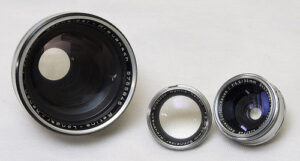SLR with central shutter
Central shutter – SLR cameras for 35mm film were offered by numerous manufacturers until 1975. Here is a small selection.
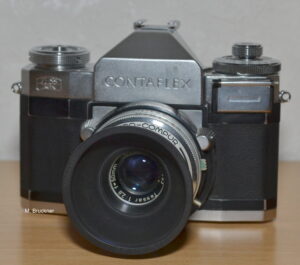
Let’s have a look at the adjacent Contaflex IV from Zeiss Ikon. This camera was introduced in 1956. As the successor to the Contaflex II, this device offered the possibility of mounting so-called set lenses instead of the front lens. This resulted in focal lengths of 35mm, 85mm and from 1961 even up to 115mm. The standard front lens ensured the normal focal length of 50 mm. When opened, the uncoupled exposure meter shows a light value that is set on a scale on the lens. Then you have assigned the correct aperture for all shutter speeds in the range. A special feature of all Contaflexes: the mirror remains folded up after the shutter release, the viewfinder is pitch black. Only after the camera is cocked again does the mirror go into the 45° position and the viewfinder is free. The range finder has two setting ranges. A split frame indicator and a focusing screen ring. This means that even motifs without clear boundary lines can be perfectly focused.

Here are the three Pro-Tessars for the Contaflex series: left 115mm, middle 85mm, right 35mm focal length. Since the distance scale on the camera side is no longer correct when the attachment lens is attached, the Pro-Tessars had a conversion scale. This is rotatable and otherwise has no function.
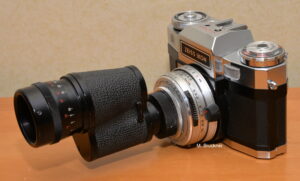
The Zeiss monocular 8 x 30B is half a pair of binoculars that was specially manufactured by Zeiss for people who wear glasses. When the Contaflex was developed with the Tessar set lens, it was found that this monocular fits perfectly into the optical system. Screwed in front of the lens like a filter with the S27 thread, this resulted in a focal length of 400mm. This had not been achieved before. However, the largest aperture was only at a value of 16, so that use is only recommended on a tripod. With an appropriate adapter, these binoculars also fit the Icarex and Contarex models. It is always an experience to watch the looks of the surrounding digital photographers when one of these combinations is used. The picture shows the Contaflex Super BC with a flanged monocular. By the way: the Zeiss binoculars are also an excellent instrument for the eye with distortion-free magnification.

The Contaflex Super, introduced in 1959, was an important development of the Contaflex series. For the first time, exposure times and aperture were linked to the exposure meter. A reflection in the viewfinder made quick adjustment possible. Zeiss Ikon even spoke a little too hastily of an „automatic exposure“. Also new was that the camera was equipped with a quick-release lever, a rewind crank and a built-in accessory shoe.
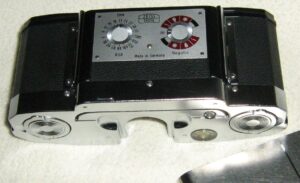
Little changed on the lens, only the distance setting was oddly reversed. It’s amazing that the light meter still delivers accurate values today. The possibility of attaching interchangeable magazines to the camera in order to swap between color and black-and-white film, for example, has been implemented as a further innovation on the Contaflex Super.

An innovation in camera technology was presented to the public by Zeiss Ikon in 1963: „The designers have succeeded in taking another fundamental step towards simplifying the recording technique with the automatic aperture of the Contaflex Super B. The automatic system automatically sets the appropriate aperture for a preselected exposure time. A display in the viewfinder provides information about the selected aperture and time pairing and warns of over- or underexposure.“ And all this with a mechanical camera that still doesn’t need batteries. The Super B is, in my opinion, the most perfect Contaflex. The viewfinder image is of a brightness that even reflex cameras from the 90s can hardly achieve, the automatic system is sufficiently accurate even under strange lighting conditions and the fully mechanical flair simply cannot be surpassed.
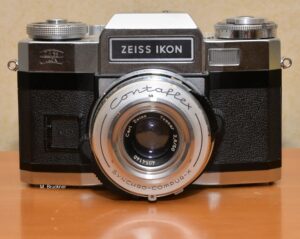
The culmination of the Contaflex development was the Super BC in 1965. This was the first time Zeiss Ikon had used exposure metering through the lens. (TTL full aperture metering) The Contaflex Super BC can be recognized by the small battery compartment on the right side of the housing. The exposure measurement itself is carried out by a CdS cell above the viewfinder eyepiece.
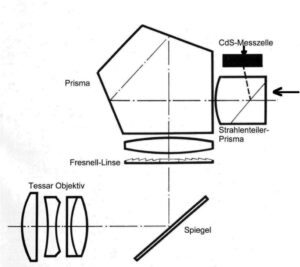 Due to this construction, the viewfinder is a little bit darker compared to the Super B. However, because of the new system, more accurate and faster measurements are possible. A battery test button and an eyepiece cover with a slider should make the Contaflex unrivaled for a long time. However, the concept was finally exhausted from a technical point of view. Zeiss Ikon should have started developing an electronic single-lens reflex camera with a focal plane shutter and fully interchangeable lenses by now.
Due to this construction, the viewfinder is a little bit darker compared to the Super B. However, because of the new system, more accurate and faster measurements are possible. A battery test button and an eyepiece cover with a slider should make the Contaflex unrivaled for a long time. However, the concept was finally exhausted from a technical point of view. Zeiss Ikon should have started developing an electronic single-lens reflex camera with a focal plane shutter and fully interchangeable lenses by now.
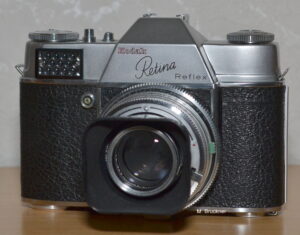
Of course, other companies also offered SLR cameras with a central shutter.
Here the Retina Reflex from Kodak. My camera is from the first series of the successful Retina Reflex series.
The basic body with film transport lever and rear wall was taken from the folding retina, the pentaprism and the mirror device correspond roughly to that of a Contaflex IV. What is unusual about the Kodak is the excellent standard lens, a six-lens „Retina-Xenar“ from Schneider-Kreuznach with a large aperture from 1:2. Unlike the Contaflex, all front lenses are changed here, so the sensitive shutter blades are exposed.
From left to right: Longar Xenon 80mm f/4, Xenon 50mm f/2, Curtar Xenon 35mm f/5.6. These attachment lenses also fit the Kodak Retina IIc (folding cameras)
With the Bessamatic, Voigtländer had one of the most beautiful cameras of the 50s and 60s in its range.

In addition to solid workmanship, the famous Voigtländer lenses made the Bessamatic a successfully sold camera. By the end of their production in 1969, there were ten! Various lenses to choose from, including the legendary Zoomar 36 – 82mm. With the Bessamatic, the entire lens is changed. Exposure metering can be easily checked using a pointer in the viewfinder, and distance setting is made much easier thanks to a sectional image.
The movable display of the depth of field directly on the lens is also helpful, the Synchro-Compur shutter sets times of 1sec. up to 1/500sec. available.

In 1965 the modernized Ultramatic CS from Voigtländer came into the photo shops. The most expensive Voigtländer model (664 DM for the housing) no longer had an automatic swing-back mirror (the mechanics of the Ultramatic with selenium exposure metering had proven to be permanently faulty), but the automatic shutter control with two CdS cells with the correct values was replaced provided. The pleasing design of the constructor Walter Swarofsky could not change the declining sales of this camera model. After around 10,000 cameras had been produced, the Ultramatic came to an end in 1968.
In 1960, Agfa offered an extraordinary 35mm SLR camera. Constructed as a double-lens camera, the Flexilette was probably intended to attract customers from the Rolleiflex warehouse to 35mm film.
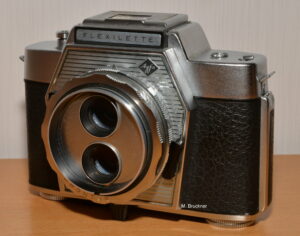
The camera itself is quite spartan. Neither an exposure meter nor an automatic function of any kind support the photographer in his work. In addition, focusing with the light shaft viewfinder is not an easy task due to the 35mm format. A small fold-out magnifying glass helps. The central shutter also offers the usual class times of 1sec. up to 1/500sec. At 45mm, the focal length of the lens is designed slightly in the direction of the wide angle.
After only one year, the small Flexilette disappeared from the market, and the successor model, the Agfa Optima Reflex, was not a real sales success either, despite the automatic and reflex viewfinder.


The Franzis company offers a camera in the style of a Rolleiflex in their catalogue. The single-lens reflex camera with waist-level viewfinder, which takes photos with 135 35mm film, can be assembled quite quickly thanks to the good instructions.
A spring-loaded slingshot mechanism is used as the shutter, which ensures an exposure time of approx. 1/125sec. The aperture is fixed at approx. f:1/5.6, but can be stopped down to f:1/11 with a plastic ring. The lenses of both lenses are made of plastic, which has long been the norm for Kodak cheap cameras.
The light shaft can be folded up, the object to be photographed is reflected on a ground glass screen and can also be correctly focused with a little practice. Putting the camera together is a lot of fun and the finished device is by no means a Rolleiflex, but you can take photos with it when the weather is nice.
Go to SLR with focal plane shutter or start page

